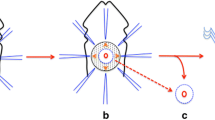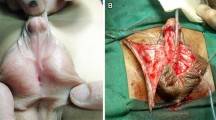Abstract
Objective
To evaluate the outcomes of three surgical techniques for the closure of urethrocutaneous fistula (UCF) after hypospadias repair.
Materials and methods
Fifty-one patients (mean age 6.5 years) who underwent UCF closure between June 1998 and February 2008 were divided in to three groups depending on fistula size; group I had <2 mm and (n = 17, 33.4%), group II had 2–4 mm (n = 21, 41.2%) and group III had >4 mm or multiple fistulas (n = 13, 25.4%). Group I patients were treated by excision and simple closure. Patients in group II and III were treated with flip flap technique along with the wrapping of repaired area with scrotal dartos flap and tunneled tunica vaginalis flap (TVF), respectively.
Results
Mean surgical time was 45 min (range 30–55), 60 min (range 50–75) and 80 min (range 60–100) in three techniques, respectively. The mean follow-up was 3.5 years (range 6 months–10 years). No patient had recurrence of fistula in group III, while 2 (9.5%) and 4 (25.4%) patients in groups II and I, respectively, had recurrent UCF. No postoperative complications were encountered in the testis or the scrotum. No patient had torsion or deviation of penis.
Conclusion
Simple fistula closure carries a higher risk of recurrence even in small sized fistulas. The application of scrotal dartos or TVF for wrapping the repaired area gives excellent results and they are easy to harvest with no harmful effects on the scrotum or testis.

Similar content being viewed by others
References
Ghali AMA, El-Malik EMA, Al-Malki T, Ibrahim AH (1999) One-stage hypospadias repair: experience with 544 cases. Eur Urol 36:436
Nuininga JE, Robert PE, Verschuren R, Feitz FJ (2005) Long-term outcome of different types of 1-stage hypospadias repair. J Urol 174:1544–1548
Demirbilek S, Kanmaz T, Aydin G, Yucesan S (2001) Outcomes of one-stage technique for proximal hypospadias repair. Urology 58:267
Uygur MC, Unal D, Tan MO, Germiyanoglu C, Erol D (2002) Factors affecting outcome of one stage anterior hypospadias repair: analysis of 422 cases. Pediatr Surg Int 18:142
Shankar KR, Losty PD, Hopper M, Wong L, Rickwood AM (2002) Outcome of hypospadias fistula repair. BJU Int 89:103
Waterman BJ, Renschler T, Cartwright PC, Snow BW, de Vries CR (2002) Variables in successful repair of urethrocutaneous fistula after hypospadias surgery. J Urol 168:726
Latifoglu O, Yavuzer R, Ünal S, Cavusoglu T, Atabay K (2000) Surgical treatment of urethral fistulas following hypospadias repair. Ann Plast Surg 44:381
Goldstein HR, Hensle TW (1981) Simplified closure of hypospadias fistulas. Urology 5:504–505
Elbakry A (2001) Management of urethrocutaneous fistulae after hypospadias repair: 10 years’ experience. BJU Int 88:590–595
Holland AJ, Abubacker M, Smith GH, Cass DT (2008) Management of urethrocutaneous fistula following hypospadias repair. Pediatr Surg Int 24(9):1047–1051
Galtzeiler J, Belman B (1984) Results of closure of urethrocutaneous fistulas in children. J Urol 132:734–736
Santangelo K, Rushton HG, Belman AB (2003) Outcome analysis of simple, complex urethrocutaneous fistula closure using a de-epithelialized or full thickness skin advancement flap for coverage. J Urol 170:1589
Cimador M, Castagnetti M, de Grazia E (2003) Urethrocutaneous fistula repair after hypospadias surgery. BJU Int 92:621
Churchill BM, van Savage JG, Khoury AE, McLorie GA (1966) The dartos flap as an adjunct in preventing urethrocutaneous fistula in repeat hypospadias surgery. J Urol 156:2047
Yamataka A, Ando K, Lane GL, Miyano T (1998) Pedicled external spermatic fascia flap for urethroplasty in hypospadias, closure of urethrocutaneous fistula. J Pediatr Surg 33:1788
Landau EH, Gofrit ON, Meretyk S, Katz G, Golijanin D, Shenfeld OZ et al (2003) Outcome analysis of tunica vaginalis flap for the correction of recurrent urethrocutaneous fistula in children. J Urol 170:1596
Routh JC, Wolpert JJ, Reinberg Y (2006) Tunneled tunica vaginalis flap is an effective technique for recurrent urethrocutaneous fistulas following tubularized incised plate urethroplasty. J Urol 176:1578–1581
Singh RB, Pavithran NM (2004) Tunica vaginalis interposition flap in the closure of massive disruption of the neourethral tube (macro urethrocutaneous fistulae). Pediatr Surg Int 20(6):464–466
Gürdal M, Karaman MI, Kanberoğlu H, Kireççi S (2003) Tunica vaginalis reinforcement flap in reoperative Snodgrass procedure. Pediatr Surg Int 19(9–10):649–651
Author information
Authors and Affiliations
Corresponding author
Rights and permissions
About this article
Cite this article
Muruganandham, K., Ansari, M.S., Dubey, D. et al. Urethrocutaneous fistula after hypospadias repair: outcome of three types of closure techniques. Pediatr Surg Int 26, 305–308 (2010). https://doi.org/10.1007/s00383-009-2490-z
Accepted:
Published:
Issue Date:
DOI: https://doi.org/10.1007/s00383-009-2490-z




